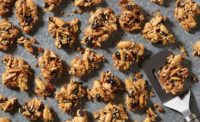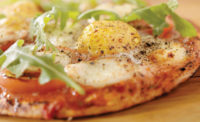Each January, companies specializing in flavors and colors for the food industry share their insights into prevailing and up-and-coming consumer taste trends. Offering baked goods and snacks in sync with these trends helps brands stand out in the marketplace and potentially become category leaders.
Understanding current views on emerging exotic flavors can be crucial to a manufacturer’s bottom line. After all, when it comes to food, taste and flavor perception—a key aspect of color choices—still drive sales, and we continue to see both new and familiar flavor and color ingredients driving innovation.
Emerging perspectives
When it comes to baked goods, flavor mash-ups are still prevalent. “We are seeing a lot of savory flavors appearing in baked goods that are typically sweet, like doughnuts, muffins and cupcakes,” says Denise Radke, marketing manager, QualiTech Inc., Chaska, MN. “This results in flavor pairings like chocolate muffins with chili inclusions. Consumers also love adding heat to sweet and smoky flavors, such as maple bacon.”
Judson McLester, executive chef/ingredient sales manager, McIlhenny Co., Avery Island, LA, cites sweet heat as a leading trend—think Tabasco dark chocolate brownies or chocolate chip cookies. “We have dry systems that work without all the vinegar,” he explains.
Pepper preferences continue to evolve. Dax Schaefer, corporate executive chef, Asenzya, Oak Creek, WI, hears a lot of buzz around newer flavors like harissa, a Meghrebian hot chili pepper paste, and gochujang, a Korean condiment made with red chiles, fermented soybeans, glutinous rice and salt.
Other hot combinations can be found in smoked, charred and burned flavors. “I’m looking at burnt sugar, with the nice caramel notes coming from cooking sugar,” says Ana Gumabon, director of R&D, California Custom Fruits & Flavors, Irwindale, CA, with these smoky or charred flavor profiles applied to ingredients like fruit, potentially ramping up flavor in a snack bar or trail mix.
Ed McIntosh, marketing manager at Flavorchem Corp., Downers Grove, IL, predicts more savory flavors and flavor mash-ups to appear in breads, trends he attributes to millennials and gen X. The company recently introduced savory bread flavors like a Middle East blend, sweet fennel and chipotle pepper.
Nostalgia is another trend still prevalent in the baked goods category. Radke cites root beer, s’mores, bubble gum, cotton candy and birthday cake as some of the more-popular nostalgic flavors.
According to Andrea Sames, director of marketing for SaltWorks Inc., Woodinville, WA, specialty salts bring unique flavors to snacks and are an excellent option for clean-label products. These include “gourmet flavors such as black and white truffle, and spicy flavors such as sriracha, chipotle and ghost pepper,” she says. “We also see a growing trend in combining sweet and salty together in a single snack.”
The SaltWorks Fusion line was created with the philosophy that “pure, natural ingredients just taste better,” Sames says. “So we start with pure, unrefined sea salt and use a proprietary process to actually fuse an all-natural flavor with the salt. Similarly, we have a line of smoked salts that are naturally cold-smoked over real wood. These smoked salts can bring the flavor of barbecue to potato chips, popcorn or even chocolate.”
Whether American or international, regional flavors continue to emerge. “Thai cuisine is becoming more popular, and now people understand that there are many versions of curry,” says Schaefer. “Another example is Mexican cuisine. Snack producers can now gain inspiration from specific dishes, like al pastor, pozole or cochinita pibil, he says.
Colorful discussions
A food’s color reinforces, and sometimes helps define, its flavor. Spicy, ethnic and natural flavors help dictate color trends.
“Reds will be big this year because they give the feel of spicy and hot,” says Jessica Saunders, technical manager, DairiConcepts, L.P., Springfield, MO. Many spicy snacks sport topical seasonings in varying shades of red.
“Our company has seen an increase in creating custom color solutions for companies that want bold colors to match exotic and spicy flavors,” says Katie Queen, application scientist at DDW, The Color House, Louisville, KY. “However, they still want a clean label to make their ingredient statement consumer-friendly.”
Red is also important in some dessert trends. Aminah Lewis, technical support manager, Sensient Food Colors, St. Louis, points to continued interest in red velvet. The color started as a seasonal offering, but now has become a permanent addition to the company’s line.
And then there’s the all-natural ingredients trend. “Converting from synthetic to natural color does not necessarily mean having to compromise on shade vibrancy or consistency,” says Lewis. ”There are a lot of new options available. It is not necessarily true that natural colors are less stable, but natural color solutions are more complicated and can vary greatly, depending on the application.”
Natural colors sometimes require more due diligence. “Snack seasonings formulated with natural colors present unique challenges around maintaining color consistency and stability,” says Saunders. “For example, working with paprika or turmeric extracts to formulate product color, rather than synthetic FD&C Yellow 5, requires additional testing in our manufacturing facilities.”
Formulating with natural colorants requires improved tactics to deliver color vibrancy and intensity, says Tanu Tokle, senior scientist, QualiTech. “We also have to take steps to ensure that the source of the natural color—which could be cabbage, red radish or beet juice—does not carry a strong flavor, incompatible with the finished product,” she explains. “Natural colorants such as anthocyanins may change shade due to pH changes during baking or processing. Process stability and shelf life of the colorant may also be impacted by temperature and exposure to light.”
Brian Sethness, sales and marketing manager, Sethness Products Co., Lincolnwood, IL, expects to see “more Class I offerings, additional non-GMO-verified products as well as more reduced 4-Mel Class III and Class IV caramel colors. Class I caramel colors are the fastest-growing segment because they meet demand for cleaner labels on food and beverages. One of our newest products is SB245 Class I caramel color. It is our strongest Class I powder and is formulated to be 4-Mel-free, as well as GMO-free.”
Consumer expectations regarding food colors are evolving. “While consumers want appealing colors, a less-vibrant color is becoming more acceptable,” says Gumabon. “There is also a trend toward more purples and greens, as these colors translate to a more-healthy food. For example, consumers seem to connect purple to high antioxidants, such as dark berries, and dark green, because of its association, to kale.”
Color factors strongly into trying a snack or baked good for the first time. And after tasting, shoppers will often instantly know whether they will buy the product again.








